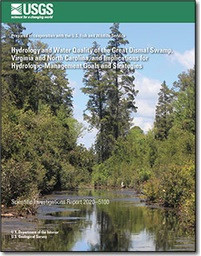
Product Details
- Product Number
- 527692
- Series
- SIR-2018-5056
- Scale
- NO SCALE
- Alternate ID
- SIR-2018-5056
- ISBN
- 978-1-4113-4248-4
- Authors
- FREDERIC C WURSTER
- Version Date
- 01/01/2018
- Countries
- USA
- Media
- Paper
- Format
- Bound
Additional Details
- Description
-
First posted August 16, 2018
For additional information, contact:
Director, Virgina Water Science Center U.S. Geological Survey 1730 East Parham Road Richmond, VA 23228
Abstract
The U.S. Geological Survey (USGS), in cooperation with the U.S Fish and Wildlife Service, has investigated the hydrology of the Great Dismal Swamp (Swamp) National Wildlife Refuge (Refuge) in Virginia and North Carolina and developed a three-dimensional numerical model to simulate groundwater and surface-water hydrology. The model was developed with MODFLOW-NWT, a USGS numerical groundwater flow modeling program, in combination with the Surface-Water Routing Process, a software package that simulates dynamic surface-water flows, water control structure management, and groundwater/surface-water interactions.
The steady-state model was calibrated to average spring conditions by using automated parameter estimation software (PEST) to reduce simulation errors and assess model parameter sensitivity. The model was then used to simulate wet and dry climatic conditions and a variety of hypothetical scenarios in which water levels in the Swamp were raised and lowered by simulated management of water control structures. Results of the model simulations indicate that, under average spring conditions, precipitation is the primary water input (92%); surface-water (5%) and groundwater (3%) inflows make up the remainder. The primary outflow (or loss) is evapotranspiration (55%), with surface outflows (about 41%) and groundwater outflow (about 4%) making up the remainder.
Simulated adjustment of water control structure weir levels demonstrates that groundwater levels are affected by water levels in adjacent ditches and that surface-water and groundwater levels can be controlled through management of water control structures, allowing the Refuge to better manage fire risks and preserve forested-wetland ecosystems in the Refuge. The 13 water control structures proposed in the simulated scenario representing possible future conditions effectively raised simulated water levels in the northeastern corner of the study area, a goal of the Refuge management.
Results of this study demonstrate use of MODFLOW with the Surface-Water Routing Process for simulating water management options in peat wetlands and will help Refuge managers to better understand existing hydrologic conditions, assess the hydrologic effects of planned changes to water control structures, and apply the new simulation tool to guide water management on the Refuge.
- Print Date
- 2018
- Height In Inches
- 11.000
- Width In Inches
- 0.150
- Length In Inches
- 8.500
- Two Sided
- Yes
- Pieces
- 1
- Languages
- English



